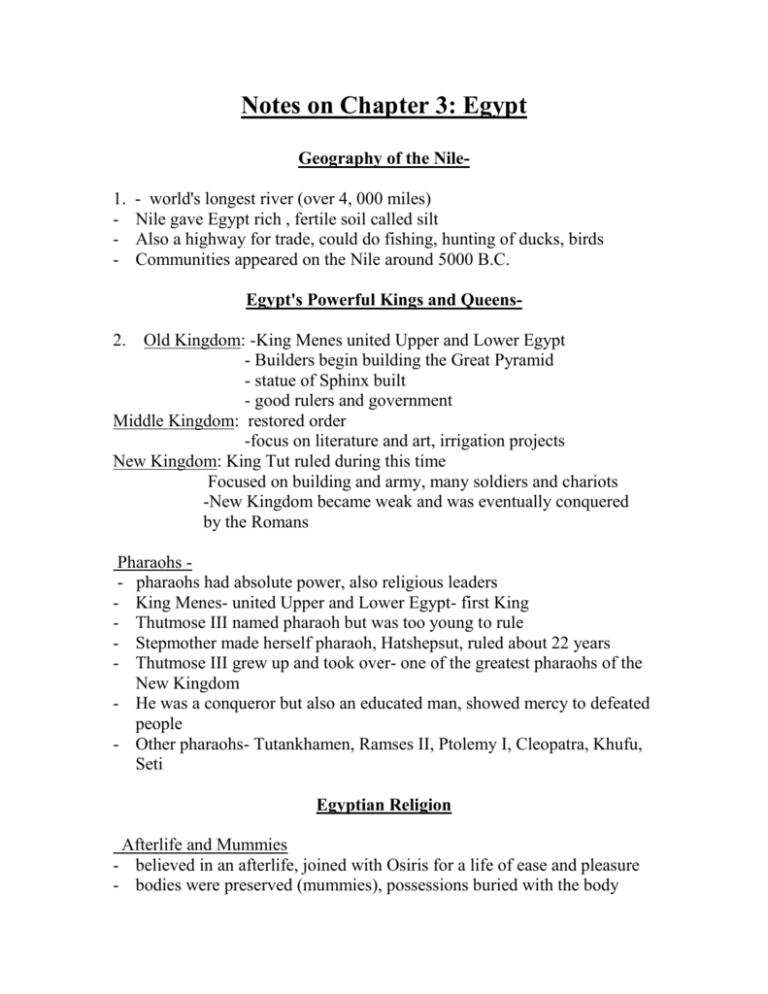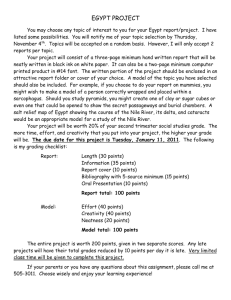Egypt - gst boces
advertisement

Notes on Chapter 3: Egypt Geography of the Nile1. - - world's longest river (over 4, 000 miles) Nile gave Egypt rich , fertile soil called silt Also a highway for trade, could do fishing, hunting of ducks, birds Communities appeared on the Nile around 5000 B.C. Egypt's Powerful Kings and Queens- 2. Old Kingdom: -King Menes united Upper and Lower Egypt - Builders begin building the Great Pyramid - statue of Sphinx built - good rulers and government Middle Kingdom: restored order -focus on literature and art, irrigation projects New Kingdom: King Tut ruled during this time Focused on building and army, many soldiers and chariots -New Kingdom became weak and was eventually conquered by the Romans Pharaohs - pharaohs had absolute power, also religious leaders - King Menes- united Upper and Lower Egypt- first King - Thutmose III named pharaoh but was too young to rule - Stepmother made herself pharaoh, Hatshepsut, ruled about 22 years - Thutmose III grew up and took over- one of the greatest pharaohs of the New Kingdom - He was a conqueror but also an educated man, showed mercy to defeated people - Other pharaohs- Tutankhamen, Ramses II, Ptolemy I, Cleopatra, Khufu, Seti Egyptian Religion Afterlife and Mummies - believed in an afterlife, joined with Osiris for a life of ease and pleasure - bodies were preserved (mummies), possessions buried with the body - took 2-3 months, 20 layers of bandages - 3-4 coffins (sarcophagus was the outside coffin) Pyramids - built as tombs for the pharaohs - most built during the Old Kingdom- Great Pyramid at Giza - required a great deal of organization - 20 or more years to build a pyramid Gods and Goddesses - religion explained the workings of nature (why there was no rain, what caused sickness) - tried to please their Gods - many looked like humans with animals' heads - Amon-Re - chief God, protected everyone - Osiris- God of the afterlife - Isis- powerful Egyptian Goddess, protected children (wife of Osiris) - Horus- God of the Sky (son of Osiris) - Thoth- God of Wisdom and Writing Culture of the Ancient Egyptians Daily Life - had social classes - Pharaohs- ruled Egypt - Priests, member's of Pharaohs Court, Nobles- upper class - Merchants and Skilled Workers- middle class (artisans) - Peasants- largest class, mostly farming or building, worked the land of the wealthy, busiest time was during the harvest -could move up social classes, by serving the pharaoh -women played a great role (own property, run businesses, some noble women could influence the pharaoh) Achievements of Egypt - developed heiroglyphics- pictures stood for ideas or sounds - better way to keep track of Egypt's money - developed a way to keep track of time through astronomy (figured out the length of a year to be 365 days) - contibutions to medicine (could perform surgery, remedies to help with headaches, fever) King Tut: Tutankhamen -became pharaoh at age 9, around 1333 BC - ruled until age 17 or 18- speculate he was murdered or sent to battle to be killed - buried in place called the “Valley of the Kings”- tombs cut into the side of hills, about 62 tombs located here - King Tut’s tomb discovered on November 4th 1922 by Howard Carter, many treasures discovered - Some believe in mummy’s curse over tomb of King Tut Geography of the Nile- Section 1 pg.60-66 1. - - world's longest river (over 4, 000 miles) Nile gave Egypt rich , fertile soil called silt Also a highway for trade, could do fishing, hunting of ducks, birds Communities appeared on the Nile around 4000 B.C. Geography of the Nile- Section 1 pg.60-66 1. - - world's longest river (over 4, 000 miles) Nile gave Egypt rich , fertile soil called silt Also a highway for trade, could do fishing, hunting of ducks, birds Communities appeared on the Nile around 4000 B.C. Geography of the Nile- Section 1 pg.60-66 1. - - world's longest river (over 4, 000 miles) Nile gave Egypt rich , fertile soil called silt Also a highway for trade, could do fishing, hunting of ducks, birds Communities appeared on the Nile around 4000 B.C. Geography of the Nile- Section 1 pg.60-66 1. - - world's longest river (over 4, 000 miles) Nile gave Egypt rich , fertile soil called silt Also a highway for trade, could do fishing, hunting of ducks, birds Communities appeared on the Nile around 4000 B.C. Geography of the Nile- Section 1 pg.60-66 1. 7. - - world's longest river (over 4, 000 miles) Nile gave Egypt rich , fertile soil called silt Also a highway for trade, could do fishing, hunting of ducks, birds Communities appeared on the Nile around 4000 B.C. Achievements of Egypt developed heiroglyphics- pictures stood for ideas or sounds better way to keep track of Egypt's money developed a way to keep track of time through astronomy (figured out the length of a year to be 365 days) - contibutions to medicine (could perform surgery, remedies to help with headaches, fever) Achievements of Egypt - developed heiroglyphics- pictures stood for ideas or sounds - better way to keep track of Egypt's money - developed a way to keep track of time through astronomy (figured out the length of a year to be 365 days) - contibutions to medicine (could perform surgery, remedies to help with headaches, fever) Achievements of Egypt - developed heiroglyphics- pictures stood for ideas or sounds - better way to keep track of Egypt's money - developed a way to keep track of time through astronomy (figured out the length of a year to be 365 days) - contibutions to medicine (could perform surgery, remedies to help with headaches, fever) Achievements of Egypt - developed heiroglyphics- pictures stood for ideas or sounds - better way to keep track of Egypt's money - developed a way to keep track of time through astronomy (figured out the length of a year to be 365 days) - contibutions to medicine (could perform surgery, remedies to help with headaches, fever) Achievements of Egypt - developed heiroglyphics- pictures stood for ideas or sounds - better way to keep track of Egypt's money - developed a way to keep track of time through astronomy (figured out the length of a year to be 365 days) - contibutions to medicine (could perform surgery, remedies to help with headaches, fever)






